Low-Complexity Transmit Power Control for Secure Communications in Wireless-Powered Cognitive Radio Networks
Abstract
:1. Introduction
- We present a practical system model for WPCRNs, in which multiple SUs share the same spectrum with PUs and EH nodes are not allowed to interpret information but are licensed to collect energy from the transmitted signals.
- To prevent eavesdropping of untrusted EH nodes and share the spectrum efficiently, an optimization problem is formulated to derive the optimal transmit powers of SU transmitters (Txs) to maximize the average secrecy rate of SUs while ensuring the requirements of allowable interference on PU receiver (Rx) and minimum amount of energy for each EH node. Given that the formulated problem is non-convex, dual decomposition is performed to identify the suboptimal value of the transmit power and develop a low complexity TPC strategy.
- Performance evaluations based on intensive simulations show that the proposed scheme achieves near-optimal performances in terms of the average secrecy rate and outage probability and significantly reduces the computational complexity compared with the optimal scheme.
2. System Model and Problem Statement
3. Low-Complexity Transmit Power Control Algorithm
| Algorithm 1 Low-complexity transmit power control algorithm |
1: Randomly initialize , , and 2: repeat 3: 4: for to N 5: Compute according to (18) 6: Compute according to (17) 7: Update , and according to (19) 8: end for 9: 10: until |
4. Simulation Results and Discussion
- Optimal scheme: With the complete CSI at SU Txs, the ES can attain near-optimal performance with .
- Proposed TPC scheme: The transmit powers of SU Txs are determined using the proposed algorithm described in Algorithm 1.
- Binary TPC scheme: The transmit power of each SU Tx is determined as either or zero in the direction of maximizing the average secrecy rate [17].
- Maximum power scheme: The transmit powers of SU Txs are always determined as their maximum transmit powers, .
- Random power scheme: The transmit powers of SU Txs are randomly determined.
5. Conclusions
Funding
Institutional Review Board Statement
Informed Consent Statement
Data Availability Statement
Conflicts of Interest
References
- Chen, X.; Chen, H.; Meng, W. Cooperative communications for cognitive radio networks - From theory to applications. IEEE Commun. Surv. Tutor. 2014, 16, 1180–1192. [Google Scholar] [CrossRef]
- Salam, A.O.A.; Sheriff, R.E.; Al-Araji, S.R.; Mezher, K.; Nasir, Q. Adaptive threshold and optimal frame duration for multi-taper spectrum sensing in cognitive radio. ICT Exp. 2019, 5, 31–36. [Google Scholar] [CrossRef]
- Chen, Y.; Yu, G.; Zhang, Z.; Chen, H.; Qiu, P. On cognitive radio networks with opportunistic power control strategies in fading channels. IEEE Trans. Wirel. Commun. 2008, 7, 2752–2761. [Google Scholar] [CrossRef]
- Ren, W.; Zhao, Q.; Swami, A. Power control in cognitive radio networks: How to cross a multi-lane highway. IEEE J. Sel. Areas Commun. 2009, 27, 1283–1296. [Google Scholar] [CrossRef] [Green Version]
- Almalfouh, S.M.; Stuber, G.L. Interference-aware radio resource allocation in OFDMA-based cognitive radio networks. IEEE Trans. Veh. Technol. 2011, 60, 1699–1713. [Google Scholar] [CrossRef]
- Zhang, Y.; So, A.M. Optimal spectrum sharing in MIMO cognitive radio networks via semidefinite programming. IEEE J. Sel. Areas Commun. 2011, 29, 362–373. [Google Scholar] [CrossRef] [Green Version]
- Zheng, G.; Ho, Z.; Jorswieck, E.A.; Ottersten, B. Information and energy cooperation in cognitive radio networks. IEEE Trans. Signal Process. 2014, 62, 2290–2303. [Google Scholar] [CrossRef] [Green Version]
- Yin, S.; Zhang, E.; Qu, Z.; Yin, L.; Li, S. Optimal cooperation strategy in cognitive radio systems with energy harvesting. IEEE Trans. Wirel. Commun. 2014, 13, 4693–4707. [Google Scholar] [CrossRef]
- Liu, X.; Zheng, K.; Chi, K.; Zhu, Y.H. Cooperative spectrum sensing optimization in energy-harvesting cognitive radio networks. IEEE Trans. Wirel. Commun. 2020, 19, 7663–7676. [Google Scholar] [CrossRef]
- Liu, X.; Li, F.; Na, Z. Optimal resource allocation in simultaneous cooperative spectrum sensing and energy harvesting for multichannel cognitive radio. IEEE Access 2017, 5, 3801–3812. [Google Scholar] [CrossRef]
- Wang, Y.; Wang, Y.; Zhou, F.; Wu, Y.; Zhou, H. Resource allocation in wireless powered cognitive radio networks based on a practical non-linear energy harvesting model. IEEE Access 2017, 5, 17618–17626. [Google Scholar] [CrossRef]
- Xu, L.; Nallanathan, A.; Pan, X.; Yang, J.; Liao, W. Security-aware resource allocation with delay constraint for NOMA-based cognitive radio network. IEEE Trans. Inf. Forensics Secur. 2018, 13, 366–376. [Google Scholar] [CrossRef]
- Xu, D.; Li, Q. Resource allocation for cognitive radio with primary user secrecy outage constraint. IEEE Syst. J. 2018, 12, 893–904. [Google Scholar] [CrossRef]
- Xu, L.; Cai, L.; Gao, Y.; Xia, J.; Yang, Y.; Chai, T. Security-aware proportional fairness resource allocation for cognitive heterogeneous networks. IEEE Trans. Veh. Technol. 2018, 67, 11694–11704. [Google Scholar] [CrossRef]
- Li, M.; Yin, H.; Huang, Y.; Wang, Y.; Yu, R. Physical layer security in overlay cognitive radio networks with energy harvesting. IEEE Trans. Veh. Technol. 2018, 67, 11274–11279. [Google Scholar] [CrossRef]
- Lee, W.; Ban, T.; Jung, B.C. Distributed transmit power optimization for device-to-device communications underlying cellular networks. IEEE Access 2019, 7, 87617–87633. [Google Scholar] [CrossRef]
- Gjendemsjø, A.; Gesbert, D.; Øien, G.E.; Kiani, S.G. Binary power control for sum rate maximization over multiple interfering links. IEEE Trans. Wirel. Commun. 2008, 7, 3164–3173. [Google Scholar] [CrossRef] [Green Version]
- Kalamkar, S.S.; Banerjee, A. Secure communication via a wireless energy harvesting untrusted relay. IEEE Trans. Veh. Technol. 2017, 66, 2199–2213. [Google Scholar] [CrossRef] [Green Version]
- Lee, W.; Lee, K. Resource allocation scheme for guarantee of QoS in D2D communications using deep neural network. IEEE Commun. Lett. 2021, 25, 887–891. [Google Scholar] [CrossRef]
- Wyner, A.D. The wire-tap channel. Bell Syst. Tech. J. 1975, 54, 1355–1387. [Google Scholar] [CrossRef]
- Boyd, S.; Vandenberghe, L. Convex Optimization; Cambridge University Press: Cambridge, UK, 2004. [Google Scholar]
- Yu, W.; Lui, R. Dual methods for nonconvex spectrum optimization of multicarrier systems. IEEE Trans. Commun. 2006, 54, 1310–1321. [Google Scholar] [CrossRef] [Green Version]
- Fliege, J.; Vaz, A.I.F.; Vicente, L.N. Complexity of gradient descent for multiobjective optimization. Optim. Methods Softw. 2018, 34, 949–959. [Google Scholar] [CrossRef] [Green Version]
- Lu, X.; Wang, P.; Niyato, D.; Kim, D.I.; Han, Z. Wireless networks with RF energy harvesting: A contemporary survey. IEEE Commun. Surv. Tutor. 2015, 17, 757–789. [Google Scholar] [CrossRef] [Green Version]
- Sengly, M.; Lee, K.; Lee, J.-R. Joint optimization of spectral efficiency and energy harvesting in D2D networks using deep neural network. IEEE Trans. Veh. Technol. 2021, 70, 8361–8366. [Google Scholar] [CrossRef]
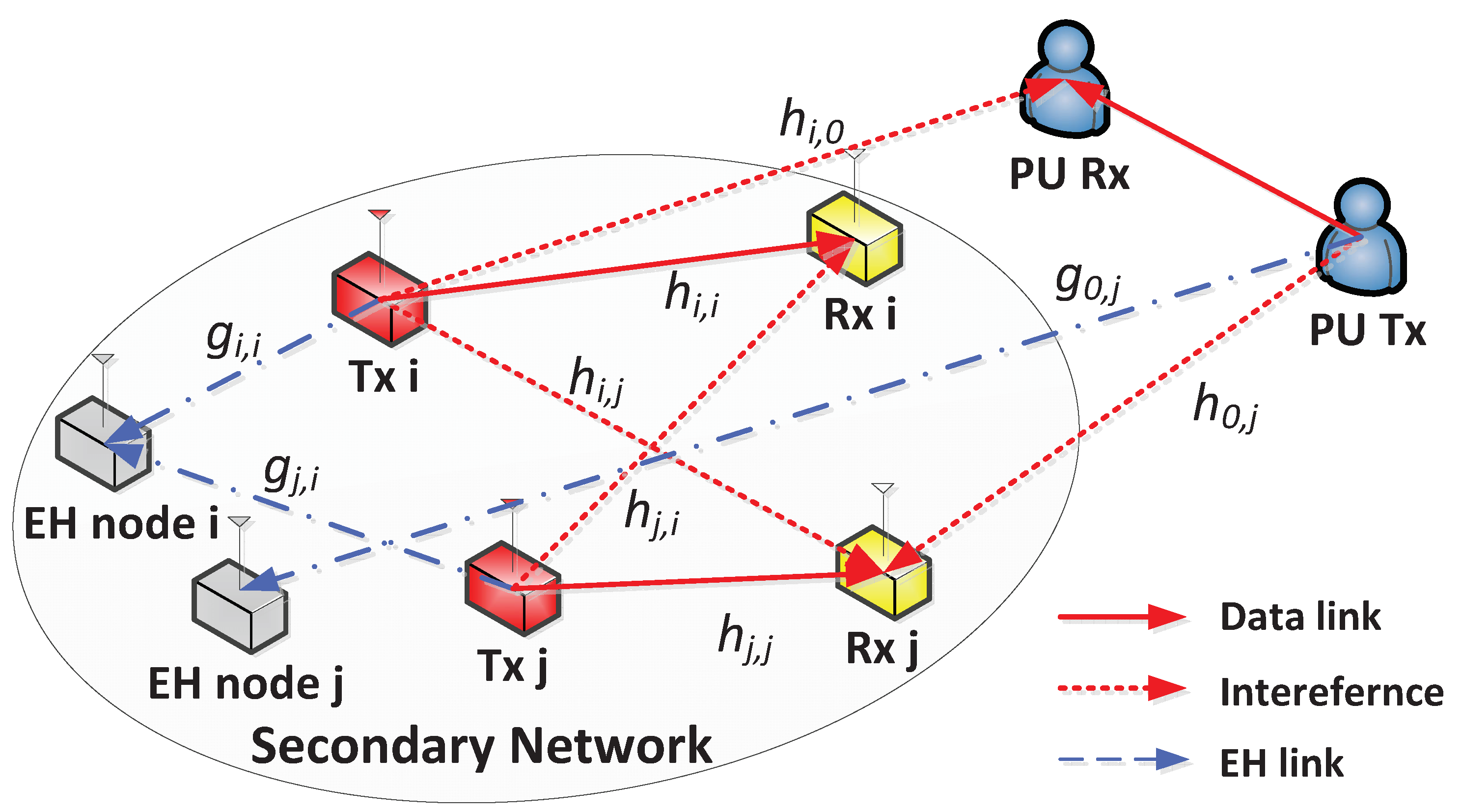
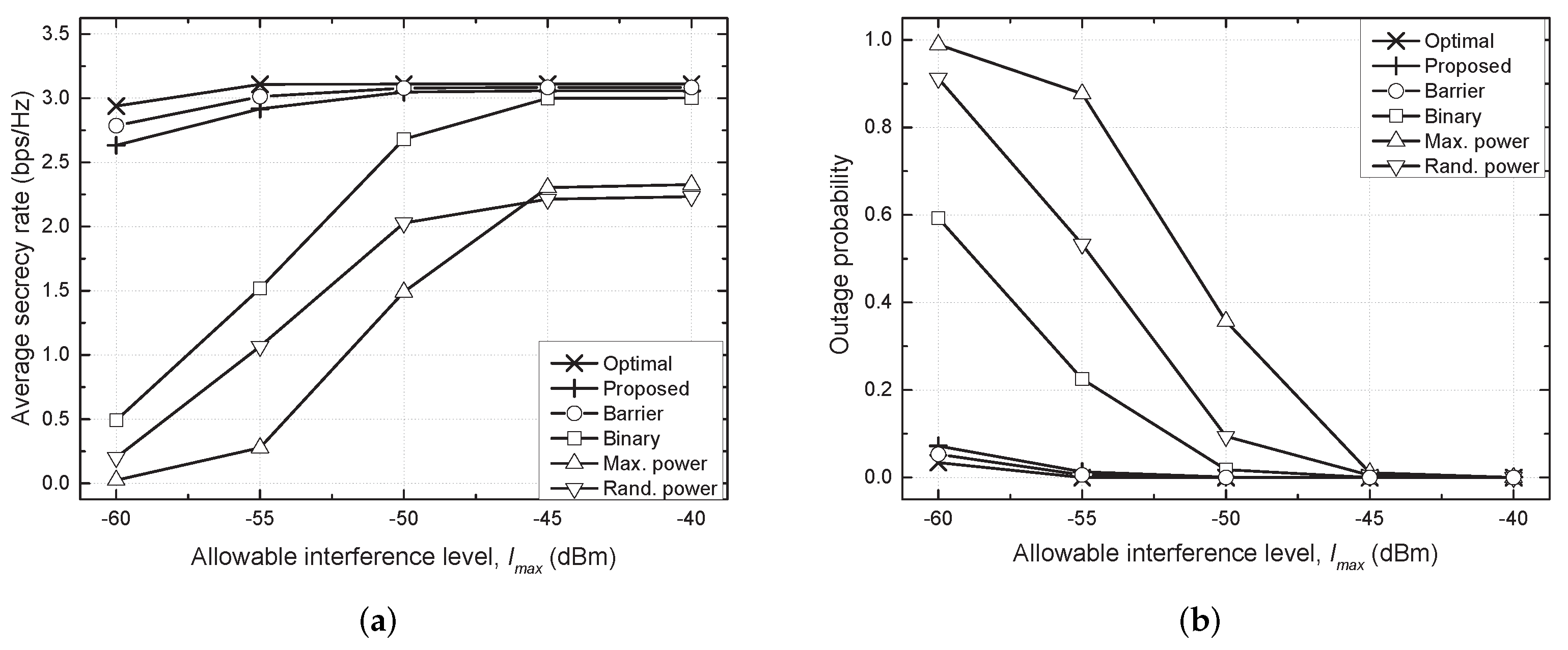
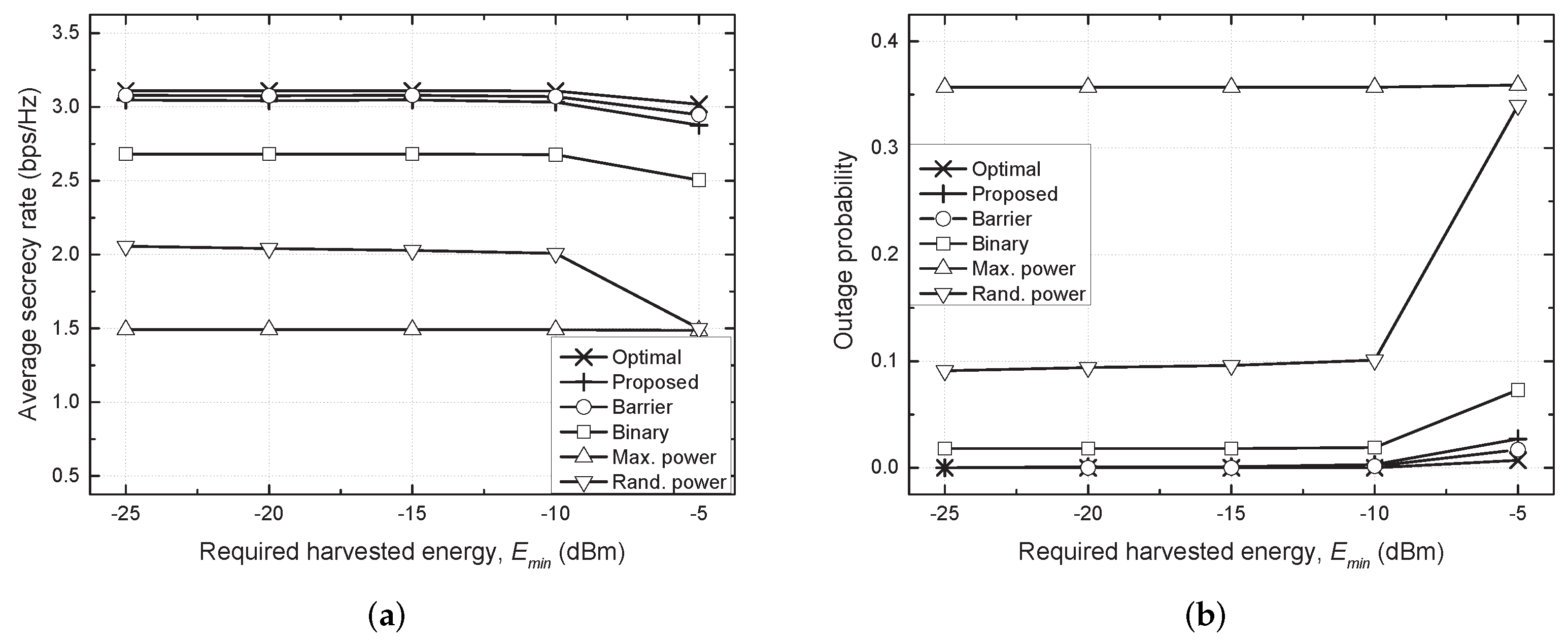
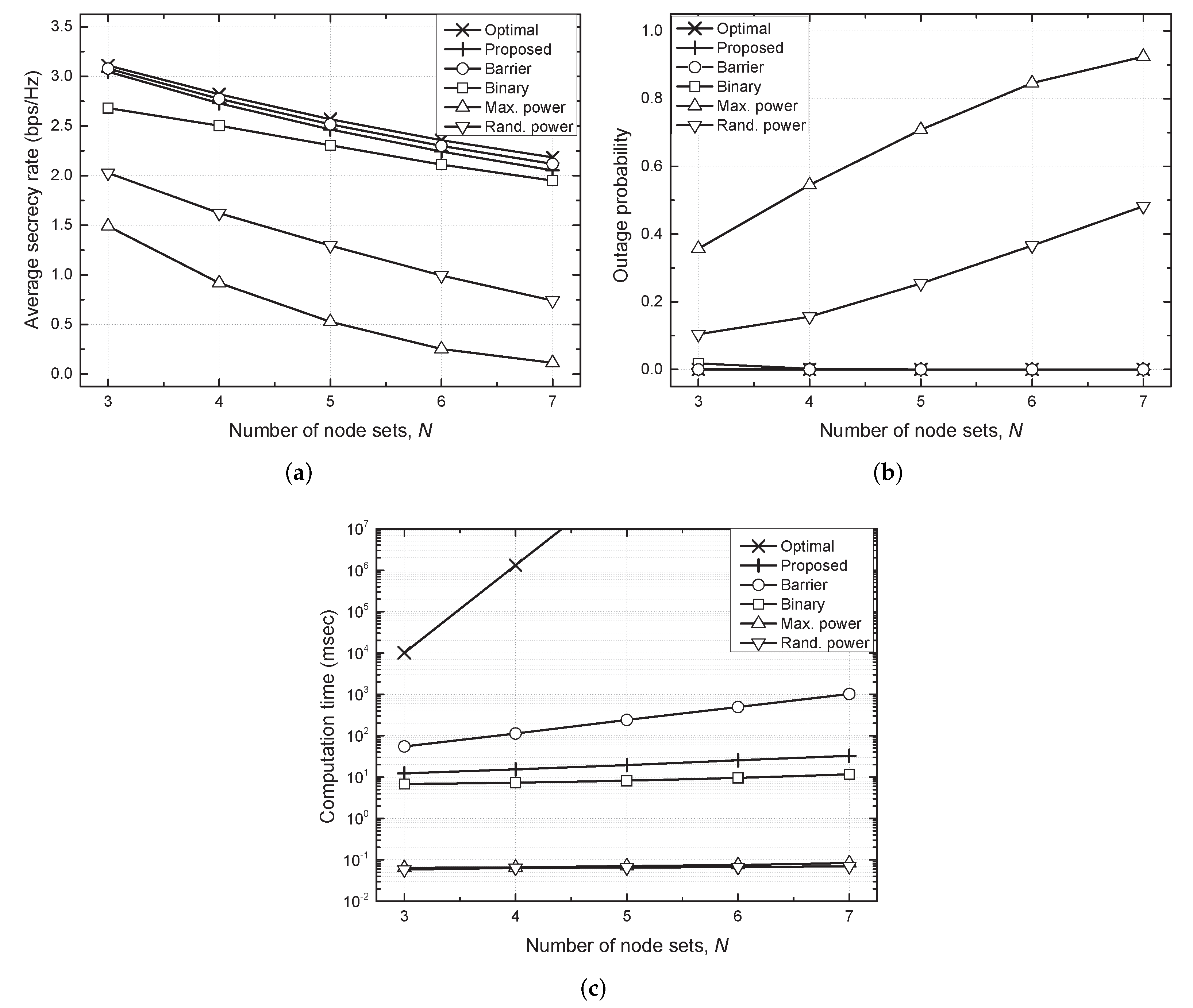
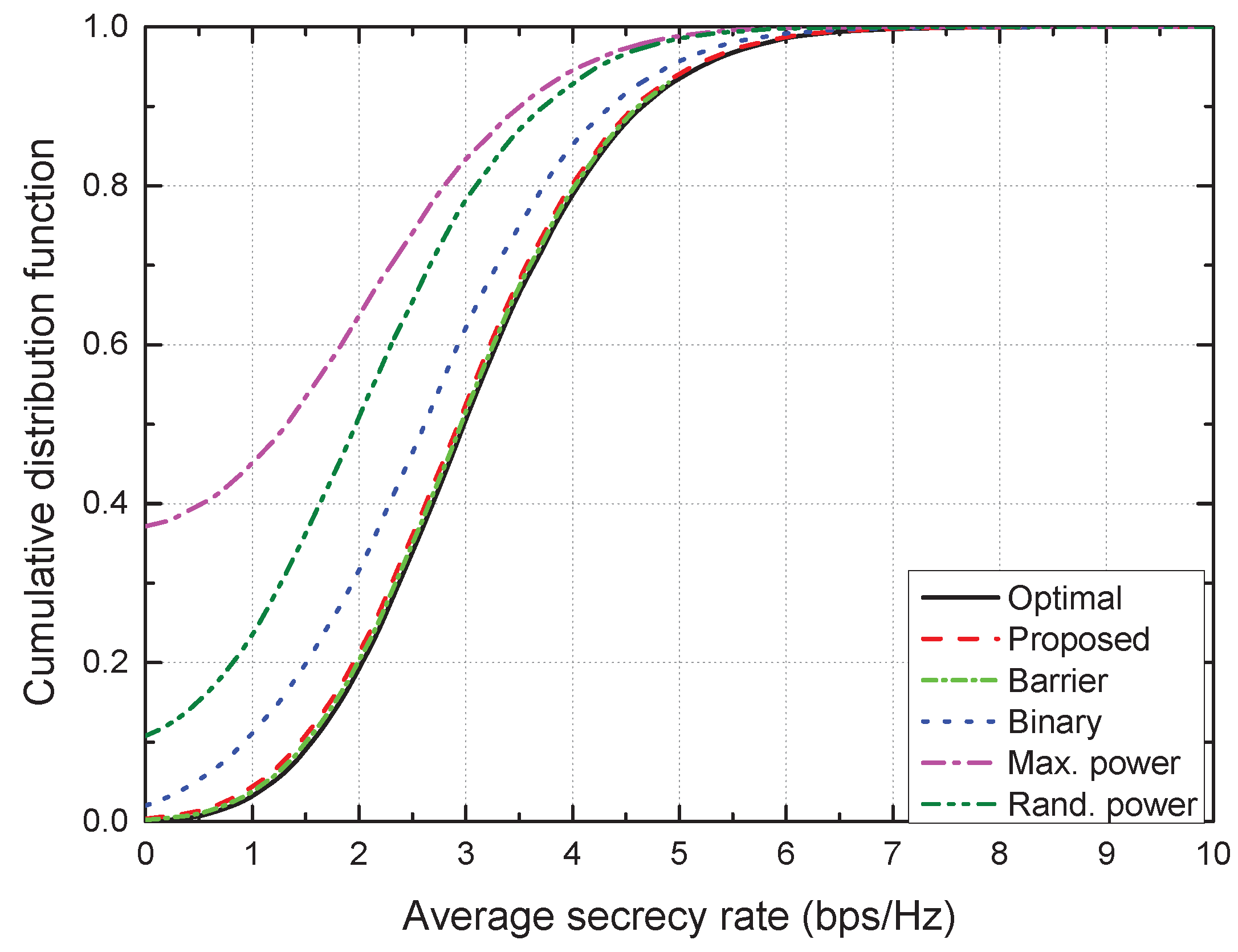
| Parameter | Value |
|---|---|
| Number of node sets | N = 3 |
| Maximum transmit power for SU Txs | = 30 dBm |
| Transmit power for PU Tx | = 30 dBm |
| Noise power | dBm |
| Required harvested energy | dBm |
| Allowable interference level | dBm |
| Energy conversion efficiency for EH nodes | = 0.5 for |
| Size of area for distributing nodes | 50 m × 50 m |
| Path loss exponent | 2.7 |
| K-factor of Rician fading | 6 |
Publisher’s Note: MDPI stays neutral with regard to jurisdictional claims in published maps and institutional affiliations. |
© 2021 by the author. Licensee MDPI, Basel, Switzerland. This article is an open access article distributed under the terms and conditions of the Creative Commons Attribution (CC BY) license (https://creativecommons.org/licenses/by/4.0/).
Share and Cite
Lee, K. Low-Complexity Transmit Power Control for Secure Communications in Wireless-Powered Cognitive Radio Networks. Sensors 2021, 21, 7837. https://doi.org/10.3390/s21237837
Lee K. Low-Complexity Transmit Power Control for Secure Communications in Wireless-Powered Cognitive Radio Networks. Sensors. 2021; 21(23):7837. https://doi.org/10.3390/s21237837
Chicago/Turabian StyleLee, Kisong. 2021. "Low-Complexity Transmit Power Control for Secure Communications in Wireless-Powered Cognitive Radio Networks" Sensors 21, no. 23: 7837. https://doi.org/10.3390/s21237837
APA StyleLee, K. (2021). Low-Complexity Transmit Power Control for Secure Communications in Wireless-Powered Cognitive Radio Networks. Sensors, 21(23), 7837. https://doi.org/10.3390/s21237837






